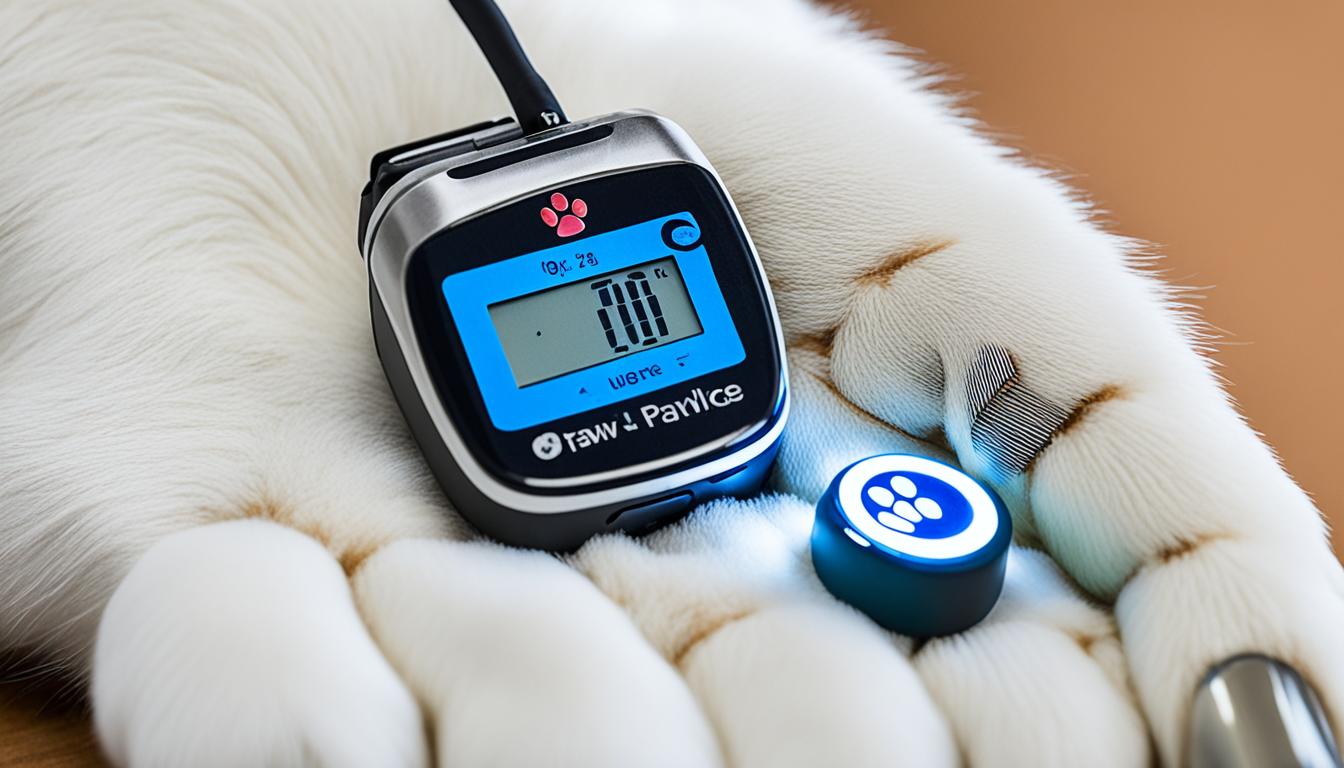Diabetes in dogs is a common metabolic disorder that affects up to 1% of all dogs during their lifetime. It revolves around a lack of insulin or a lack of the body’s response to insulin. Early diagnosis, proper treatment, and careful monitoring are essential for managing diabetes in dogs and helping them live full and active lives.
Recognizing the symptoms of diabetes in dogs is crucial for early detection and prompt treatment. Excessive thirst, increased urination, unexplained weight loss, and changes in behavior are some common signs to watch out for. If your dog exhibits these symptoms, it’s important to consult a veterinarian for a proper diagnosis and treatment plan.
Treatment for diabetes in dogs typically involves insulin therapy, which may require regular injections. Your veterinarian will guide you on the proper administration and dosage of insulin for your dog. In addition to insulin therapy, a tailored diabetic dog diet can help manage blood sugar levels and promote overall health.
Regular monitoring of glucose levels in dogs is vital to ensure proper management of diabetes. This can be done through periodic blood tests and observing your dog’s behavior and appetite. Monitoring glucose levels helps determine the effectiveness of treatment and allows for necessary adjustments, if required.
Key Takeaways:
- Diabetes in dogs is a common metabolic disorder.
- Early diagnosis and treatment are crucial for managing diabetes in dogs.
- Insulin therapy is often required, along with a customized diabetic dog diet.
- Regular monitoring of glucose levels is essential for effective management.
- Consulting with a veterinarian is important for proper diagnosis and care.
Understanding Your Dog’s Prognosis
Early diagnosis plays a crucial role in a dog’s prognosis for managing diabetes. The timely identification of diabetes in dogs can significantly improve the chances of successful management. It allows for immediate intervention, enabling pet owners to take the necessary steps to control the disease effectively.
Dogs with high levels of phosphate in their blood at the time of diagnosis may have a slightly less positive prognosis. Elevated phosphate levels can indicate advanced disease progression, which may require more intensive management strategies. Regular monitoring of phosphate levels is essential to evaluate the dog’s response to treatment and adjust the therapeutic approach accordingly.
The dog’s medical history also plays a significant role in determining prognosis. Factors such as age, weight, history of pancreatitis or Cushing’s disease, and the use of glucocorticoids should be considered. These variables can impact the dog’s response to treatment and influence the overall prognosis.
Certain breeds, such as Border Terriers, West Highland White Terriers, and Cocker Spaniels, may have lower survival times compared to other breeds. Understanding breed-specific variations can help veterinarians tailor treatment plans and provide more accurate prognostic information to pet owners.
Additionally, females have a higher risk of developing diabetes. However, if properly managed, spaying can help mitigate the risk and ensure better long-term prognosis. It is important for pet owners to consult with their veterinarian about spaying options and the potential impact on managing diabetes in female dogs.
Factors Affecting Prognosis in Diabetic Dogs
Several factors can contribute to the prognosis for diabetic dogs:
- Age and weight: Younger dogs and dogs with a healthy weight tend to have a better prognosis.
- Medical history: Dogs with a history of pancreatitis or Cushing’s disease may have a more challenging prognosis.
- Phosphate levels: Elevated phosphate levels at diagnosis can indicate advanced disease progression.
- Glucocorticoid use: The use of glucocorticoids can impact insulin resistance and affect the dog’s response to treatment.
- Breed: Certain breeds may have lower survival times, requiring close monitoring and specialized management.
“Early diagnosis and proper management are key factors that contribute to a favorable prognosis in diabetic dogs. By closely working with your veterinarian and following their guidance, you can ensure the best possible outcome for your furry companion.” – Dr. Samantha Thompson, DVM
| Factor | Impact on Prognosis |
|---|---|
| Age | Younger dogs tend to have a better prognosis. |
| Weight | Dogs with a healthy weight have a better prognosis. |
| Medical History | History of pancreatitis or Cushing’s disease may complicate prognosis. |
| Phosphate Levels | Elevated phosphate levels at diagnosis can indicate advanced disease progression. |
| Glucocorticoid Use | The use of glucocorticoids can impact insulin resistance and prognosis. |
| Breed | Certain breeds may have lower survival times and require specialized management. |
Starting Therapy for Diabetes in Dogs
Once a definitive diagnosis of diabetes in dogs is confirmed, the next step in treatment usually involves starting therapy with insulin injections. While dogs who are severely ill may initially require hospitalization, most dogs can be treated at home under the guidance of a veterinarian. It is crucial to customize the treatment plan as different dogs may respond differently to various types of insulin.
Dosages and timing of insulin injections may vary among individual dogs. Veterinary professionals will determine the appropriate dosage and frequency of injection based on several factors such as the dog’s weight, blood glucose levels, and overall health. Regular monitoring of the dog’s blood glucose levels is essential to ensure that the insulin therapy is effective in managing the diabetes.
Proper handling, storage, and administration of insulin are critical for the success of the treatment. Insulin should be stored as instructed by the manufacturer to maintain its potency. Additionally, it is important for dog owners to learn proper injection techniques to ensure accurate and safe administration of insulin.
“Starting therapy for diabetes in dogs involves customized insulin injections, individualized dosages, and proper handling and administration techniques.”
Insulin Therapy and its Role
Insulin therapy plays a crucial role in managing diabetes in dogs by replacing the insufficient insulin production or improving the body’s response to insulin. Insulin injections are necessary because oral insulin is not available for dogs. Injecting insulin subcutaneously (under the skin) enables its direct absorption into the bloodstream, where it can regulate blood glucose levels.
The effectiveness of insulin therapy can be tracked by monitoring blood glucose levels, which helps determine if adjustments to insulin dosage or timing are necessary. Regular consultations with a veterinarian are essential to evaluate the dog’s response to the treatment and make any necessary modifications to ensure optimal diabetes management.
It is important to note that insulin therapy is an integral part of a larger comprehensive treatment plan for diabetic dogs. This includes regular veterinary check-ups, a healthy and balanced diet, exercise, and continuous monitoring of the dog’s overall health.
Insulin-Glucose Response Curve
To fine-tune a dog’s treatment for diabetes, veterinarians often utilize an insulin-glucose response curve. This curve provides critical insights into how the dog’s body responds to insulin and helps guide adjustments in insulin dose, meal timing, and feeding amounts. Regular monitoring of blood glucose levels, both at the veterinary clinic and at home, is crucial for effectively managing diabetes in dogs.
During the creation of the insulin-glucose response curve, blood glucose levels are measured every two hours over a 12-hour period. By checking blood glucose levels at regular intervals, veterinarians can determine the effectiveness of the insulin being administered. This curve helps assess when the insulin starts to take effect, how long it remains active, and when its effects begin to fade.
This valuable information enables veterinarians to refine the treatment plan and make necessary adjustments. Based on the results of the curve, the veterinarian may recommend changes to the insulin dose, timing of meals, or quantity of food provided. These adjustments aim to achieve stable and well-regulated blood glucose levels in diabetic dogs.
Regular monitoring of blood glucose levels is an essential part of managing diabetes in dogs. This includes both periodic visits to the veterinary clinic for professional monitoring as well as at-home monitoring by pet owners. By keeping a close eye on their dog’s blood glucose levels, pet owners can detect any changes or abnormalities and notify the veterinarian promptly.
Here is a visual representation of an insulin-glucose response curve:
| Time Point | Blood Glucose Level (mg/dL) |
|---|---|
| 0 hours | 220 |
| 2 hours | 180 |
| 4 hours | 145 |
| 6 hours | 115 |
| 8 hours | 130 |
| 10 hours | 175 |
| 12 hours | 210 |
This sample insulin-glucose response curve demonstrates how blood glucose levels change over time following insulin administration. These fluctuations allow veterinarians to evaluate the effectiveness of the insulin and make appropriate adjustments to the treatment plan.
Factors Influencing Insulin Dosing
When it comes to managing diabetes in dogs, several factors can influence their insulin dose requirements. By understanding these factors, pet owners can work closely with their veterinarians to create the most effective treatment plan for their diabetic dogs.
Weight Gain or Weight Loss
Changes in body weight can significantly impact the insulin dose needed for diabetic dogs. Weight gain may require increasing the insulin dose to maintain blood glucose levels within target ranges. Conversely, weight loss may necessitate adjusting the dose downward to prevent hypoglycemia.
Activity Levels
The level of activity in diabetic dogs can affect insulin dosing. Regular exercise can improve insulin sensitivity, allowing for better glucose utilization. Increased activity may require adjustments in insulin dose to avoid episodes of low blood sugar.
Heat Cycles in Female Dogs
Female dogs that experience heat cycles may have temporary changes in their insulin needs. Fluctuations in hormone levels during estrus can affect insulin sensitivity, requiring careful monitoring and adjustments in insulin doses.
Overall Health Conditions
Underlying health conditions such as infections or other diseases can impact insulin dosing. Illnesses can increase insulin resistance, leading to higher doses. Conversely, improvement in overall health may require decreasing insulin doses to avoid hypoglycemia.
Medication Use
Some medications, such as certain steroids or medications that affect glucose metabolism, can interact with insulin and influence dose requirements. Pet owners should inform their veterinarians about all medications their diabetic dogs are taking to ensure proper insulin dosing.
Regular Veterinary Check-ups and Monitoring
Regular veterinary check-ups and monitoring play a crucial role in managing diabetes in dogs. Veterinarians can assess the dog’s condition, make necessary adjustments in insulin doses, and provide guidance on maintaining stable blood glucose levels.
Pet owners should closely monitor their diabetic dogs for any changes in behavior, appetite, or water intake. Keeping a record of these observations and sharing them with the veterinarian can help identify trends and guide insulin dose adjustments if needed.
In conclusion, managing insulin dosing is a critical aspect of diabetes care in dogs. By considering factors such as weight, activity levels, heat cycles in females, overall health conditions, and medication use, pet owners can work with veterinarians to establish effective insulin doses that help maintain stable blood glucose levels and ensure the well-being of their diabetic dogs.
Monitoring Your Diabetic Dog
Regular monitoring is vital for the well-being of your diabetic dog. By keeping a close eye on their health, you can ensure their glucose levels are stable and catch any potential complications early on. Monitoring involves periodic blood tests to check glucose levels, in addition to observing changes in your dog’s behavior, appetite, thirst, urination, and activity levels. It’s essential to be aware of the signs of hypoglycemia, a condition where blood sugar levels drop too low in your dog’s body.
Signs of Hypoglycemia in Dogs
Hypoglycemia can be dangerous for diabetic dogs and should be addressed promptly. Some common signs of hypoglycemia in dogs include:
- Lethargy
- Tremors
- Weakness
- Loss of appetite
If you notice any of these symptoms in your diabetic dog, it’s important to take action immediately to prevent further complications. Providing a small amount of glucose, such as honey or a sugar solution, can help raise their blood sugar levels. However, it’s crucial to contact your veterinarian for guidance and further treatment.
Continuous or flash glucose-monitoring systems can provide a more detailed and continuous picture of your dog’s blood glucose levels. These innovative devices can help you monitor your dog’s glucose levels throughout the day and make informed decisions regarding their care and treatment.
To demonstrate the importance of monitoring your diabetic dog’s glucose levels, take a look at this illustrative example:
| Time | Blood Glucose Level (mg/dL) |
|---|---|
| 8:00 AM | 180 |
| 10:00 AM | 220 |
| 12:00 PM | 200 |
| 2:00 PM | 160 |
| 4:00 PM | 190 |
By monitoring your dog’s glucose levels at regular intervals, you can observe patterns and make adjustments to their insulin dose, timing of meals, or portion sizes as needed. This individualized approach to monitoring and treatment is key to effectively managing diabetes in dogs.
Next up, we will explore the various factors that can influence insulin dosing for diabetic dogs and how to navigate the challenges they may present.
Best Management Practices for Diabetic Dogs
When it comes to managing diabetes in dogs, the primary goal is to maintain normal blood glucose levels and minimize complications. By following the best practices for diabetic dogs, pet owners can ensure their furry companions live healthy and happy lives.
Establishing a Steady Routine
Consistency is key in managing diabetes in dogs. Establishing a steady routine for feeding and exercise can help regulate blood glucose levels. Stick to regular meal times and monitor the quantity and type of food your dog consumes.
A High-Fiber Diet
A high-fiber diet is often recommended for diabetic dogs. Fiber helps slow down the absorption of glucose and can contribute to better blood sugar control. Consult with your veterinarian to determine the most suitable diet for your dog’s specific needs.
Regular Exercise
Regular exercise is essential for managing diabetes in dogs. Engage your dog in daily physical activities such as walks or playtime, as it can help improve insulin sensitivity and overall well-being.
Regular Vet Check-Ups
Scheduling regular check-ups with your veterinarian is crucial for monitoring your dog’s diabetes management. They can perform blood tests to assess blood glucose levels and make any necessary adjustments to the treatment plan.
Maintaining a Healthy Weight
Keeping your diabetic dog at a healthy weight is important for their overall health. Obesity can exacerbate diabetes symptoms and make blood sugar control more challenging. Work with your veterinarian to develop a weight management plan if necessary.
Monitoring for Long-Term Complications
Diabetes in dogs can lead to long-term complications such as cataracts. Regular monitoring of your dog’s vision and regular check-ups with a veterinary ophthalmologist can help detect and manage these potential issues.
“By following these best practices, pet owners can provide their diabetic dogs with the care and support they need to lead happy and fulfilling lives.” – Dr. Amanda Thompson, DVM
| Best Management Practices for Diabetic Dogs | Benefits |
|---|---|
| Establishing a Steady Routine | Regulates blood glucose levels and improves insulin sensitivity |
| A High-Fiber Diet | Slows down glucose absorption and aids in blood sugar control |
| Regular Exercise | Improves insulin sensitivity and overall well-being |
| Regular Vet Check-Ups | Monitors blood glucose levels and adjusts treatment plan as needed |
| Maintaining a Healthy Weight | Helps manage diabetes symptoms and improves overall health |
| Monitoring for Long-Term Complications | Detects and manages potential issues such as cataracts |
Side Effects and Complications – Cataracts
Cataracts are a common complication of diabetes in dogs. When a dog’s blood glucose levels remain consistently high over time, it can lead to the formation of cataracts. These cataracts tend to mature quickly, leading to vision impairment in diabetic dogs.
Veterinary ophthalmologists are specialized in evaluating and treating eye conditions in animals. They play a crucial role in managing cataracts in diabetic dogs. Through a thorough examination, they can determine the severity of the cataracts and whether cataract removal surgery is necessary for the dog’s overall well-being.
Well-regulated diabetic dogs can undergo cataract surgery successfully. Although the surgery won’t restore their vision completely, it can significantly improve their quality of life. Dogs are adaptable creatures and can adjust to their loss of vision with time and support from their owners.
Regular check-ups are essential for managing complications in diabetic dogs, including cataracts. Pet owners should keep a close eye on their dog’s vision, noting any changes in clarity or behavior that may indicate worsening cataracts. Prompt communication with the veterinarian is key to addressing any emerging issues and ensuring the dog’s ongoing care and well-being.
| Signs of Cataracts in Diabetic Dogs | Management Strategies |
|---|---|
| Cloudy or opaque appearance in the eye | Regular veterinary check-ups |
| Decreased vision or blindness | Tracking changes in the dog’s vision |
| Increased bumping into objects | Ensuring a safe environment for the dog |
| Behavioral changes or increased anxiety | Providing support and reassurance to the dog |
Prognosis for Diabetic Dogs
With proper management and veterinary care, many dogs with diabetes can live full and active lives. Regular monitoring, maintaining a steady routine, and charting daily dosage, diet, and activity can help identify any developing issues. Regular vet check-ups and open communication with the veterinarian are important for tracking the dog’s progress and making any necessary adjustments to the treatment plan.
Factors Influencing Prognosis
Several factors can influence the prognosis of diabetic dogs. Early diagnosis and timely initiation of treatment play a crucial role in managing the condition. Dogs with well-controlled blood glucose levels tend to have a more positive prognosis. Additionally, factors such as the dog’s age, weight, medical history, and response to therapy can impact long-term outcomes.
Diabetic dogs with high levels of phosphate in their blood at the time of diagnosis may have a slightly less positive prognosis. Certain breeds, such as Border Terriers, West Highland White Terriers, and Cocker Spaniels, may have lower survival times. However, with appropriate care and monitoring, even dogs in these categories can lead fulfilling lives.
Regular Monitoring and Care
Regular monitoring of a diabetic dog’s health is essential for managing the condition effectively. This includes monitoring blood glucose levels, observing symptoms or changes in behavior, and tracking the dog’s response to treatment. By maintaining a detailed log of the dog’s daily medication, diet, and activity, pet owners can provide valuable information to the veterinarian during check-ups.
Veterinarian Collaboration
Collaboration with a veterinarian is crucial for optimizing the prognosis of diabetic dogs. Regular check-ups and open communication allow the veterinarian to track the dog’s progress and make necessary adjustments to the treatment plan. The veterinarian can provide guidance on medication, diet, and exercise, ensuring proper management of the condition.
A Supportive Environment
Creating a supportive environment for diabetic dogs can contribute to their overall well-being. Consistency in feeding schedules, exercise routines, and medication administration helps maintain stable blood glucose levels. Offering a calm and stress-free environment can help reduce the risk of complications and support the dog’s overall health.
| Prognostic Factors | Predictive Impact |
|---|---|
| Blood glucose control | Positive impact on prognosis |
| Presence of complications | Can impact prognosis |
| Breed | May influence survival times |
| Response to therapy | Can affect long-term outcomes |
By closely monitoring a diabetic dog’s health, working collaboratively with a veterinarian, and providing a supportive environment, pet owners can significantly improve the prognosis of their furry companions. With proper care and attention, diabetic dogs can lead full and satisfying lives.
Veterinarians and Diabetes Education
Veterinarians play a crucial role in providing diabetes education for pet owners. They are equipped with the knowledge and expertise to educate pet owners about the intricacies of diabetes in dogs. By imparting valuable information about the disease, its management, and the importance of regular check-ups and monitoring, veterinarians empower pet owners to better understand the condition and care for their diabetic pets.
Diabetes in dogs can be a complex condition to navigate, and pet owners may have numerous questions and concerns. Veterinarians serve as trusted sources of information, guiding pet owners through the various aspects of diabetes education. They explain the importance of early diagnosis, monitoring blood glucose levels, administering insulin injections, and implementing lifestyle changes for optimal management.
Through personalized consultations and comprehensive counseling sessions, veterinarians help pet owners grasp the fundamental concepts of canine diabetes. They cover topics such as recognizing the signs and symptoms of diabetes, explaining what blood glucose levels should be, and discussing the role of diet and exercise in managing the disease.
By fostering a collaborative relationship between veterinarians and pet owners, diabetes education becomes a dynamic process of equipping caregivers with the tools and knowledge needed to provide the best possible care for their diabetic dogs. This includes teaching pet owners how to monitor their dog’s blood glucose levels, identify potential complications, and seek prompt veterinary intervention when necessary.
“Diabetes education enables pet owners to develop essential skills and knowledge, empowering them to actively participate in their dog’s healthcare journey. This collaboration between veterinarians and pet owners fosters a supportive environment for ongoing learning and continuous improvement in diabetes management.”
Through effective diabetes education, pet owners gain the confidence and competence needed to navigate the challenges of caring for a diabetic dog. They become adept in recognizing the subtle changes in their dog’s behavior, appetite, and overall health. With this newfound awareness, they can promptly alert their veterinarian to any concerning developments and seek appropriate guidance.
Veterinarians are committed to equipping pet owners with the tools and knowledge they need to provide optimal care for their diabetic dogs. Their expertise, guidance, and ongoing support contribute to the well-being and quality of life of both pets and their dedicated caregivers.
Decoding Diabetes in Dogs
Diabetes is a metabolic disorder that affects dogs, disrupting their body’s processing of energy. It can be managed but not cured. Diabetes is classified into two types: insulin-deficiency diabetes (IDD) and insulin-resistance diabetes (IRD). Recognizing the symptoms, such as excessive thirst, increased urination, weight loss, and changes in behavior, is important for early detection and treatment. Genetics and environmental triggers can contribute to the development of diabetes in dogs.
Types of Diabetes in Dogs
Insulin-deficiency diabetes (IDD) occurs when the pancreas fails to produce enough insulin to regulate blood glucose levels. This type is more commonly seen in dogs.
Insulin-resistance diabetes (IRD) is characterized by a reduced response of the body’s cells to insulin, resulting in elevated blood glucose levels.
Symptoms of Diabetes in Dogs
- Excessive thirst
- Increased urination
- Weight loss
- Changes in behavior
Early detection of these symptoms is crucial for prompt diagnosis and treatment, as uncontrolled diabetes can lead to serious health complications. If you notice any of these signs in your dog, consult a veterinarian for proper evaluation and guidance.
Conclusion
Understanding and effectively managing diabetes in dogs is crucial for their overall health and well-being. With early diagnosis, personalized treatment plans, consistent monitoring, and regular veterinary check-ups, diabetic dogs can lead happy and fulfilling lives.
Diabetes in dogs, also known as canine diabetes, is a metabolic disorder that requires attention and care. By implementing a customized treatment plan, administering insulin therapy, and monitoring glucose levels, pet owners can effectively manage their dog’s diabetes.
Proper diabetic dog care involves establishing a steady routine, including consistent feeding and exercise schedules. A high-fiber diet is often recommended, along with regular exercise, to maintain normal blood glucose levels. Regular veterinary check-ups and monitoring for long-term complications, such as cataracts, are essential for managing diabetes in dogs.
By understanding the importance of early detection and treatment, pet owners can provide the necessary care and support for their diabetic dogs. With proper management and veterinary care, these dogs can continue to enjoy a full and active life.







